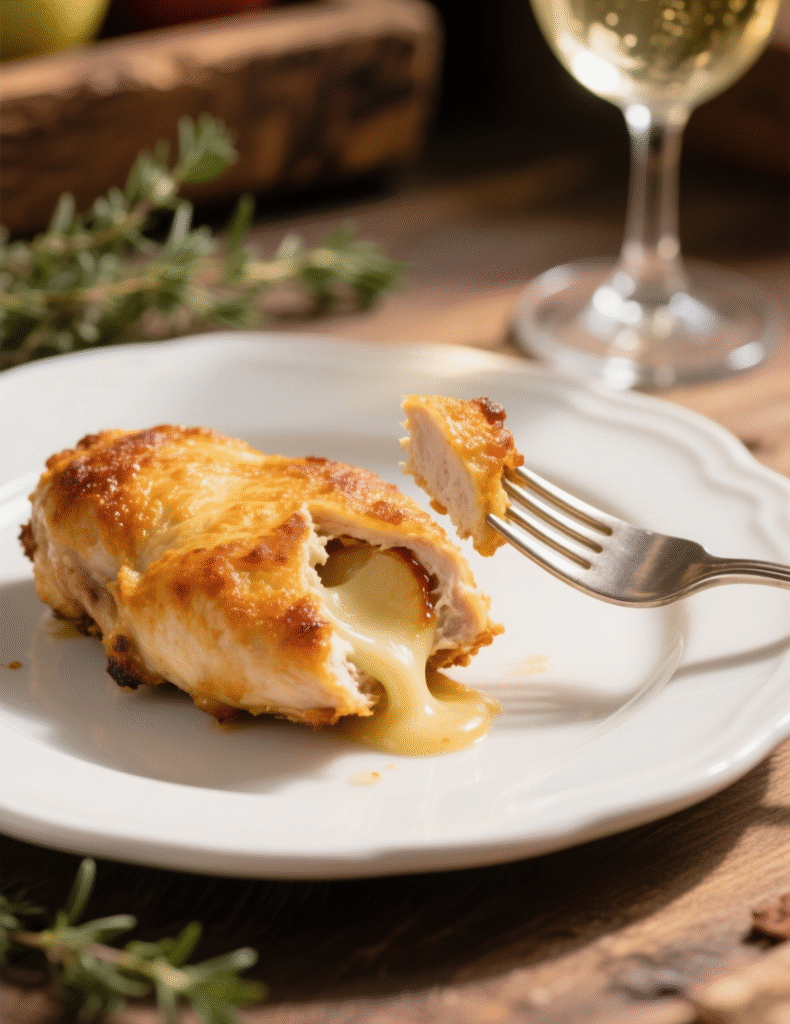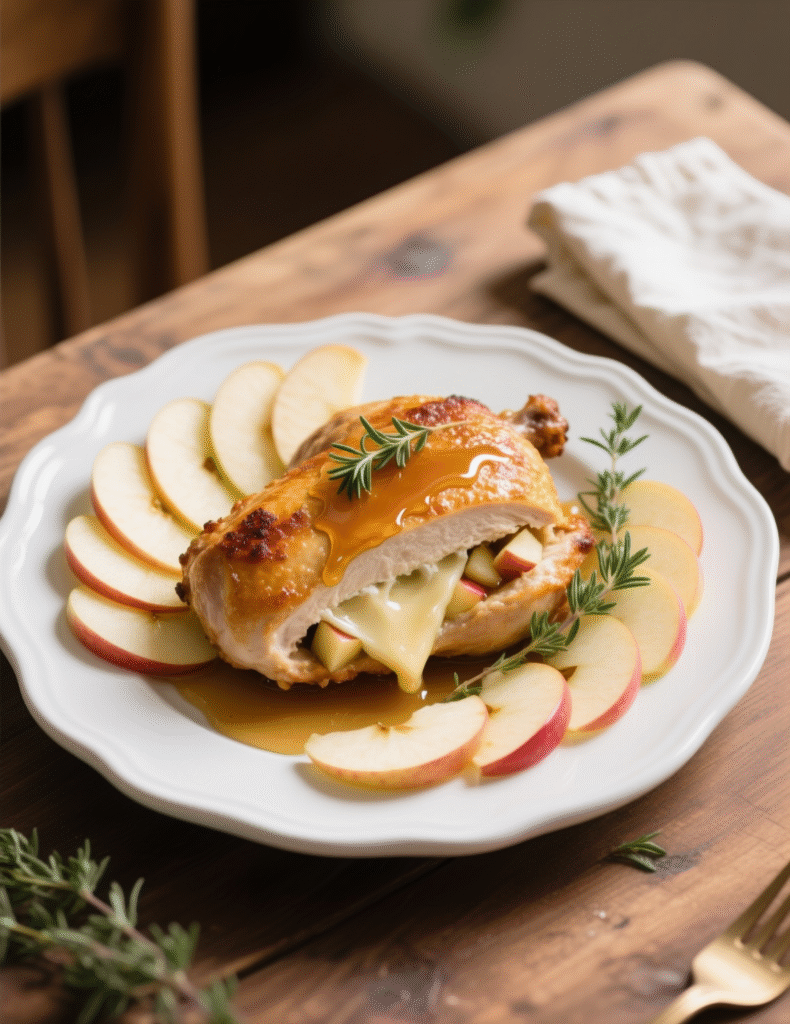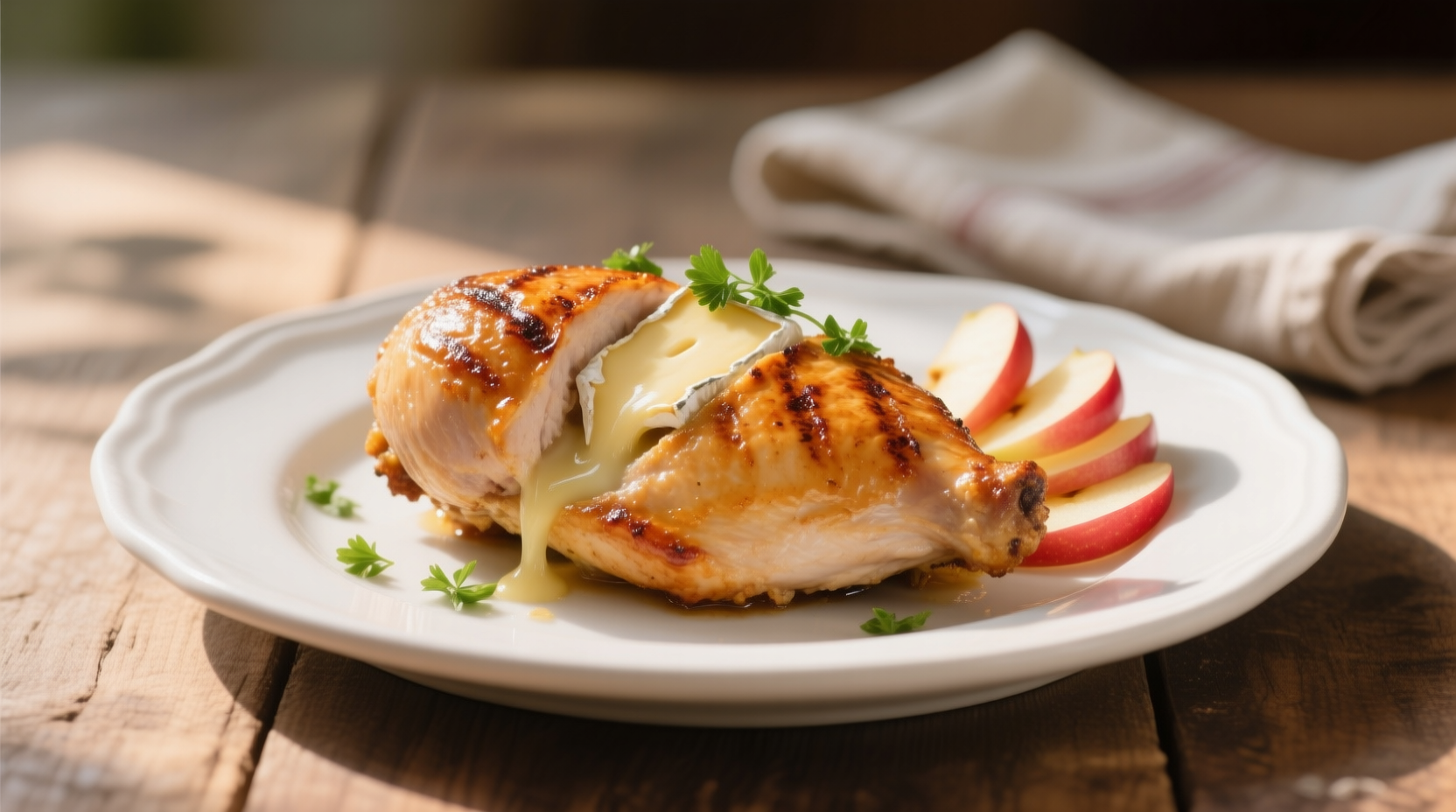Chicken by itself can be humble, almost too familiar. But when you slide creamy brie and crisp apples into its center, something strange happens. The bird takes on elegance without trying too hard. This is the sort of dish that looks like it belongs on a restaurant menu, but if you know the tricks, it’s actually quite straightforward. Today we’re digging deep into the Apple and Brie Stuffed Chicken recipe—not just how to cook it, but why it works, what to avoid, and how professionals refine it into something guests actually remember.
Why Apple and Brie Work Together
Apple and brie sound like an odd couple until you taste them layered. The apple offers bite and acidity. Brie, on the other hand, is rich, creamy, and faintly nutty. When they meet inside chicken breast, the balance of fat, sweetness, and savory proteins creates a harmony that food scientists often describe as contrast-driven synergy.
Chefs talk about balance constantly. This dish is balance written in flesh and cheese. The chicken breast, which can be dry if handled wrong, becomes a blank stage. The moisture from apples and melting brie works like a built-in insurance policy. There’s chemistry here: the apple’s malic acid helps break down muscle fibers slightly during cooking, giving tenderness. And brie’s fat—about 27g per 100g—locks in succulence where chicken usually fails.
The Anatomy of the Perfect Chicken Breast
Most mistakes with this recipe start before the stuffing even happens. A raw chicken breast is uneven—thicker at one end, thinner at the other. If you don’t level that out, you end up with part overcooked, part underdone. Professionals either butterfly the breast (slicing horizontally and opening it like a book) or pound it gently with a mallet until even. The word “gently” matters here. Smash too hard and you tear fibers, creating leaks when melted brie tries to escape.
There’s another small thing: the seasoning. Too many home cooks think the stuffing will carry the flavor. That’s wishful thinking. Salt and pepper need to hit the chicken directly, ideally a few hours before cooking so they can penetrate. A Cornell University study on meat brining showed that pre-salting increased moisture retention by up to 12%. A plain sprinkle before hitting the pan isn’t enough if you’re chasing consistency.
Choosing the Right Apples
Not all apples are made equal in a hot oven. Red Delicious? Forget it. They collapse into mush. For this recipe you want structure, acidity, and sweetness balanced. Granny Smith brings brightness and tartness that cuts brie’s fat. Honeycrisp stays firm, adds natural juice. Pink Lady offers the floral notes many chefs crave when pairing with cheese.
A trick professionals use: mixing two apple types. One for structure, one for flavor. For example, Granny Smith plus Honeycrisp. The sharper acid of Granny holds up against the buttery brie, while Honeycrisp adds a whisper of honey-like sweetness. It’s layering flavors with intention, not just tossing fruit inside poultry.

Understanding Brie in Heat
Brie is not mozzarella—it doesn’t stretch, it flows. Its melting point sits around 90°F (32°C), so by the time chicken reaches safe temperature (165°F / 74°C), the cheese is molten. This is both a gift and a hazard.
Chefs often chill or even freeze slices of brie before stuffing. Why? Because it slows down the melt during searing. Without this, the cheese leaks out before the chicken is fully cooked. Professionals also trim the rind if they want smoother melt, though others keep it for its mushroomy flavor. There’s no wrong answer, but know what you’re chasing.
Stuffing Technique: Keeping It Inside
You’d think “just stuff it” is enough. It isn’t. Cut too wide a pocket and your filling runs out. Cut too shallow and you’ll barely fit anything. The sweet spot is about two-thirds into the thickest part of the breast, creating a pouch.
Now comes the securing. Toothpicks, kitchen twine, or in some pro kitchens, chicken skin grafting—where an extra flap of skin is stretched and tucked to hold everything in place. It looks surgical, but it works. Another overlooked move: dredging the stuffed chicken lightly in flour before searing. This creates a seal that helps trap brie inside while also improving browning.
Cooking Method: Pan and Oven Collaboration
Chicken breasts stuffed with wet fillings are risky if you only pan-fry. The outside browns quickly, but the center takes longer. That’s why the best method is a hybrid: sear then bake.
Start with a hot pan—cast iron if you have it—over medium-high heat with a neutral oil like grapeseed. Get golden color on both sides, usually 2–3 minutes each. Then transfer to a 375°F (190°C) oven until internal temp hits 165°F. This two-stage cooking gives you crust without sacrificing even doneness. Professional kitchens use probes constantly here. No guessing.
One more detail: resting. At least 5 minutes before slicing. The proteins in meat reabsorb juices during this window. Skip it and you’ll lose flavor onto the cutting board instead of the plate.
Flavor Enhancements and Pairings
The base recipe is strong, but professionals rarely stop there. Herbs like thyme or rosemary tucked into the stuffing elevate complexity. Caramelized onions add sweetness that deepens apple’s brightness. Walnuts or pecans bring crunch—a textural contrast that chefs know diners always notice.
Pairings matter too. Sides with acidity—roasted Brussels sprouts with balsamic, or a salad with mustard vinaigrette—keep the dish from feeling heavy. On the wine side, Chardonnay with just a touch of oak complements brie’s creaminess, while a dry Riesling accentuates apple’s freshness. In blind tastings, sommeliers often lean toward whites with crisp acidity for this pairing.
Professional Troubleshooting
Every chef learns through failure. Some common pitfalls:
- Cheese leakage: Chill brie before stuffing, secure tightly, and don’t overfill.
- Dry chicken: Brining or at least pre-salting improves retention. Also, never cook past 165°F.
- Mushy apples: Wrong variety choice. Stick to firm, tart ones.
- Uneven cooking: Butterfly or pound chicken before stuffing.
These may sound basic, but in professional kitchens, these tiny details separate mediocre plates from memorable ones.
Nutritional Profile
This dish isn’t diet food, but it’s not indulgent without redemption either. One stuffed breast (about 6 oz chicken, 1 oz brie, half an apple) comes to roughly 370 calories, 28g protein, 20g fat, and 9g carbs. The protein density is impressive, while the fat is primarily from brie’s saturated content. Pairing with a fiber-rich side balances the macros nicely.
Nutritionists often argue for the value of pairing lean proteins with controlled portions of rich cheese. Here, the portion is self-limiting because you’re not drowning the dish in brie, you’re tucking it inside. It’s richness with restraint.

Modern Twists Emerging in Restaurants
Trends around this dish show chefs experimenting. Some replace apples with pears, chasing a softer texture. Others substitute brie with camembert or even goat brie for tang. In Nordic kitchens, lingonberries appear as a garnish to push the acidity further.
Sous-vide versions are also rising. By sealing stuffed chicken and cooking at 145°F for an hour, then searing, chefs ensure perfect doneness and almost zero leakage. The precision fits modern kitchens obsessed with consistency.
The Recipe: Professional Breakdown
Ingredients (serves 4)
- 4 boneless chicken breasts, trimmed
- 1 large Granny Smith apple, thinly sliced
- 1 Honeycrisp apple, thinly sliced
- 4 oz brie cheese, chilled and sliced
- 1 tbsp fresh thyme leaves
- 1 tbsp olive oil or neutral oil
- Salt and cracked black pepper to taste
- Optional: 1 small onion, caramelized; ¼ cup toasted walnuts
Method
- Preheat oven to 375°F (190°C).
- Butterfly chicken breasts carefully, creating deep pockets. Season with salt and pepper.
- Stuff each breast with apple slices, brie, thyme, and optional extras. Secure with toothpicks.
- Heat oil in skillet until shimmering. Sear chicken 2–3 minutes per side until golden.
- Transfer skillet to oven. Bake 15–18 minutes, or until internal temp reaches 165°F (74°C).
- Rest 5 minutes. Slice carefully across bias. Serve with roasted vegetables or light salad.
Final Thoughts
Apple and Brie Stuffed Chicken isn’t just a recipe. It’s a lesson in why contrast matters in cooking. Fat versus acid. Crisp versus creamy. Simple ingredients turned elegant by a little science and a little patience.
If you’re cooking at home, pay attention to the small details: the apple type, the brie temperature, the cut of the pocket. If you’re cooking professionally, think about how to elevate it—herbs, textures, plating. Either way, this dish proves that refinement doesn’t always come from complexity. Sometimes, it’s just about putting the right flavors in the right place at the right time.
FAQs
What apples are best for Apple and Brie Stuffed Chicken?
Granny Smith and Honeycrisp are ideal because they stay firm and balance sweetness with acidity.
Can I use another cheese instead of brie?
Yes, camembert or goat brie works well for a tangier twist.
How do I stop the cheese from leaking out?
Chill the brie before stuffing and secure the breast tightly with toothpicks.
Do I need to peel the apples?
No, the peel adds color, texture, and holds the slices together during cooking.
Should I butterfly or pound the chicken breast?
Either works, but butterflying gives a deeper pocket while pounding ensures even thickness.
Can I cook it only on the stovetop?
It’s risky; searing then finishing in the oven gives the best results.
What sides go well with this dish?
Roasted vegetables, light salads, or balsamic Brussels sprouts complement it perfectly.
Can I prepare it ahead of time?
Yes, stuff the chicken and refrigerate for up to 24 hours before cooking.
What wine pairs best with Apple and Brie Stuffed Chicken?
Chardonnay with light oak or a dry Riesling balances the flavors beautifully.
Is this recipe healthy?
It’s protein-rich and balanced if served with fiber-heavy sides, though brie adds some fat.

Mariana is a passionate home cook who creates delicious, easy-to-follow recipes for busy people. From energizing breakfasts to satisfying dinners and indulgent desserts, her dishes are designed to fuel both your body and hustle.
When she’s not in the kitchen, she’s exploring new flavors and dreaming up her next recipe to share with the Foodie Hustle community.

